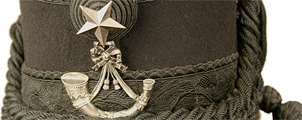Last chance to see Cameronian Curiosities exhibition!
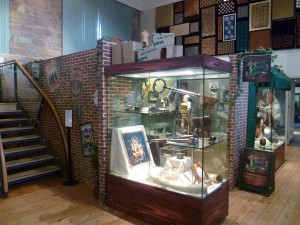
This Sunday (11th October) will be your last chance to see “Cameronian Curiosities”, our temporary exhibition showcasing some of the weird and wonderful objects from The Cameronians (Scottish Rifles) museum collections, on display in Low Parks Museum. We have some exciting new exhibitions and displays coming up in Low Parks Museum – watch this space for more updates!
If you haven’t been able to see the exhibition in the flesh, you can see some of the objects that feature in the display on our website – Cameronians Curiosities.
Don’t forget that you can also explore thousands of objects from the South Lanarkshire museum collections by using our online collections browser – Online Collection.
Comments:
Posted: 07/10/2015 by BarrieDuncan in Days out, Events
The Battle of Loos
Friday 25th September marks the anniversary of the Battle of Loos. Although later eclipsed in scale by the Battle of the Somme in 1915, at the time it was the largest attack launched by the British Expeditionary Force of the War. Loos is also significant as it was in this battle that the British Army used poisoned gas for the first time.
Four battalions of The Cameronians (Scottish Rifles) were involved in the Battle, representing the regular army (1st Battalion), the Territorial Force (1/5th Battalion), and the recently formed service battalions of the New Army (9th and 10th Battalions).
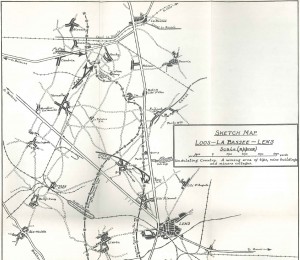
Map showing the positions of the Battalions of The Cameronians (Scottish Rifles) involved in the Battle
Loos was a mining town, and the surrounding landscape was covered in mine workings, pit heads, and slag heaps, and would have no doubt felt quite familiar to the hundreds of men from Lanarkshire who would take part in the Battle, many of whom were miners in civilian life. Even today, the slag heaps of the famous ‘Double Crassier’ dominate the skyline south of Loos.

Double Crassier, as viewed from Dud Corner Cemetery
The attack commenced at 6:30am on the morning of Saturday 25th September. Gas was released in front of the 15th Division’s position 40 minutes ahead of the attack. Unfortunately the windy conditions resulted in some of the gas drifting back towards the British front, gassing their own men.
Many of the objectives of the attacking force were met that day, but a failure to bring up reinforcements in time to take advantage of gains made saw the advance falter. The 10th Battalion in particular had made steady gains, battling their way through Loos itself and on to the secondary objective of Hill 70. There the British forces encountered heavy resistance from the German defenders and it was found impossible to maintain hold of the hill.
The 9th Battalion attacked in support of the 10th Battalion Highland Light Infantry, who had suffered heavy casualites in the initial attack. A second attack by the 9th Scottish Rifles just after noon on 25 September was repulsed with heavy casualties.
The 1st and 1/5th Battalions were the Support and Reserve battalions of the 19th Brigade in its attack. When the initial attack by the leading battalions had been halted; orders were received by the 1st Battalion to prepare for a fresh advance. Thankfully the order was later cancelled when it was pointed out by the Commanding Officer of the 1st Battalion that the chances of success of any further attack was unlikely.
One of the casualties of the Battle was Private Jack Allen of the 10th Battalion who died of wounds on 27th September. Likely wounded on 25th, Private Allen was taken to the brewery at Philosophe where a Field Ambulance of the Royal Army Medical Corps had been established, and here he succumbed to his wounds. He was buried nearby in what is now Philosophe Cemetery. Sadly, the exact whereabouts of Private Allen’s grave were either never fully recorded, or were later lost; he is now commemorated on the Loos Memorial at Dud Corner Cemetery. A letter in the museum collection does however record that he had been buried at Philosophe.
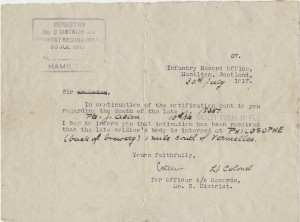
Letter relating to burial of Private Jack Allen
It is difficult to establish exactly how many soldiers of The Cameronians (Scottish Rifles) became casualties in the Battle of Loos. Initial reports in Battalion war diaries often record those who had been killed as ‘Missing’, and it would be some time before these men were confirmed to have died. The publication Soldiers Died in the Great War records that 413 soldiers from the The Cameronian battalions at Loos died on 25th September 1915. Many of the soldiers who died have no known grave, and are recorded on the Loos Memorial at Dud Corner Cemetery. This cemetery occupies the site of the Lens Road Redoubt, one of the German strongholds taken by the 15th (Scottish) Division on the first day of the Battle.
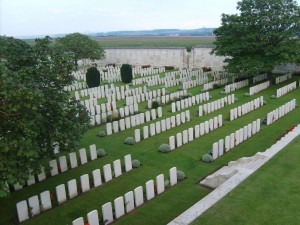
Dud Corner Cemetery. The panels on the outer wall record the names of those whose graves are unknown.
Comments:
Posted: 24/09/2015 by BarrieDuncan in First World War
Lt. Col. Douglas Graham Moncrieff Wright
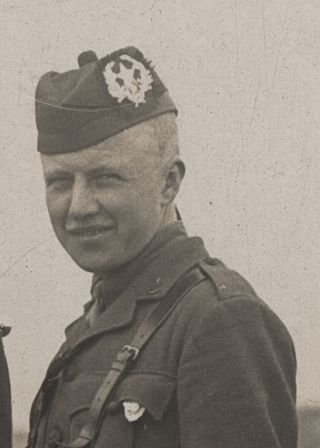
Douglas Graham Moncrieff Wright was born in Rangoon, Burma on 7th June 1893. He was the only child of Lena (née Graham) and John Moncrieff Wright of Kinmonth, Bridge of Earn, Perthshire. He was educated at Glenalmond College, Perth and then in 1912, attended the Royal Military Academy at Sandhurst. After graduation in 1913, he was gazetted to The Cameronians (Scottish Rifles) and joined the 1st Battalion at Maryhill Barracks.
With the outbreak of the First World War in August 1914, Moncrieff Wright was deployed to France with The Cameronians (Scottish Rifles) 1st Battalion. He received the Military Cross and bar for conspicuous gallantry and devotion to duty and was mentioned in dispatches twice. On 19 June 1916, The London Gazette, it was noted that, ‘He commanded a bombing attack on the enemy trenches. He led this attack with great skill and determination, his fine example inspiring those under his command.’ In 1916 he was promoted to Captain at the age of just 23.
Writing home
Douglas Graham Moncrieff Wright wrote home to his parents almost every day of the war. His letters are often short and give little hint of the hardships of life at the front. They usually contain a brief weather report and requests for items such as food, socks and writing paper. In a letter to his parents dated 16th January 1918, he wrote,
My darling Mother & Father,
Thanks very much for your letters, the kippers & butter. The butter is very good. I like it so much.
It came in very handy. I have got a nice billet & am very comfortable.
The weather is very changeable.
With much love from,
Douglas
The British Government was acutely aware of the importance of communication with home to boost the soldiers’ morale but also to maintain support from the home front. Over 12 million letters and 1 million parcels were sent to soldiers at the front every week for the duration of the First World War. A letter from home reached the front within 2 days of being sent, meaning that it was possible to send perishable foodstuffs such as kippers!
Souvenirs
By 1918 Moncrieff Wright was serving on the staff of the 33rd Division. In January 1918 he sent home German shoulder straps or epaulettes (schulterklappen in German) to his mother in Perth as souvenirs. Epaulettes, cap badges and letters could all betray the identification of a regiment or unit therefore such items were removed from the dead or prisoners of war. Collecting such items as souvenirs was commonplace amongst many soldiers, both British and German. It is most likely that these insignia were sent to the 33rd Division’s HQ for identification and once their purpose was served Moncrieff Wright kept them as mementoes.
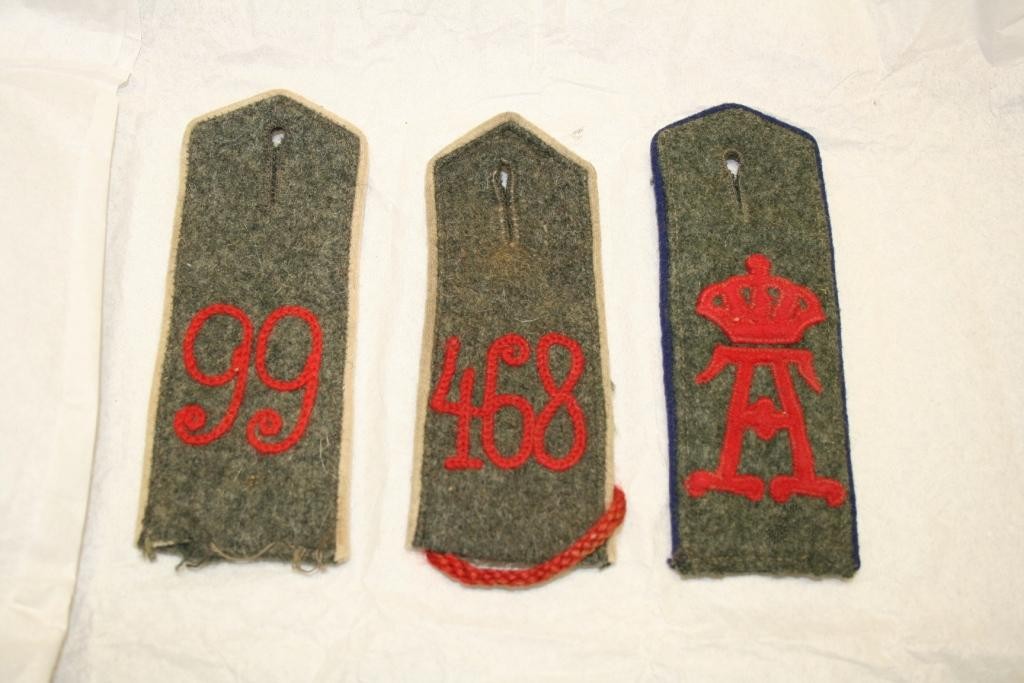
The epaulette with the red ‘A’ and crown is from a soldier who served with the 117th Grand Ducal Hessian Life Infantry, “Grand Duchess Alice,” 25th Division. The ‘468’ is from the Infanterie-Regiment 468 and the ‘99’ is a 1915-pattern for the 2nd Oberrheinisches Infanterie-Regiment Nr.99.
Life after the First World War
After the First World War Moncrieff Wright served with the 2nd Battalion in India and retired in 1930 with the rank of Major. In April 1928 he married Henrietta Doreen St. John in Bombay, India. They had four children; John Graham Wright, Charles St. John Graham Wright, Alice Rosemary Graham Wright and Dora Heather Graham Wright. John and Charles would both go on to have successful careers in the military.
With the Second World War approaching, Moncrieff Wright returned to The Cameronians and in June 1939 was gazetted to Lieutenant Colonel with the 6th Battalion. He then commanded the 10th Battalion from 1939 until 1942, and thereafter held positions on the staff of the Home Guard until his retirement in 1945.
Life Outwith the Army
Lt. Col Moncrieff Wright led a full and active life. He became a J.P. for Perthshire in 1933 and was appointed as the Deputy Lieutenant of Sutherland in 1946 (a Lord Lieutenant is appointed by the Crown to act as one of the monarch’s representatives in Scotland). He was a renowned hunter and took part in big-game shoots while in India. He was also experienced in salmon fishing and deer stalking. As a result of his expertise he was elected as a fellow of the Royal Geographical Society in 1926. He was also Chairman of the Scottish branch of the British Field Sports Society from 1952 to 1960.
He died on 1st May 1983, aged 89.
Acknowledgments
I am greatly indebted to members of the Great War Forum for their valuable information and identification of German regiments.
The epaulettes currently feature as our ‘Curator’s Choice’ and can be seen on display at Low Parks Museum, Hamilton. They will be displayed at Hamilton Townhouse Library, Rutherglen Library and Lanark Library over the next few months.
Comments:
Lieutenant George M. Alexander
We are fortunate that we hold in the collection a number of personal diaries and letters written by soldiers serving in The Cameronians (Scottish Rifles). These documents can provide fascinating glimpses into war as experienced by the soldiers who were there, while others remind us of the pain and suffering that war can bring.
This letter wasn’t written by a soldier, but by the wife of an officer who was killed in the Second World War. Lieutenant George Murdoch Alexander was killed on 30th July 1944, while serving with the 9th Battalion Cameronians. His widow wrote this letter to a friend, in reply to a letter of sympathy. The black border on the paper is a sign that the writer is in mourning:
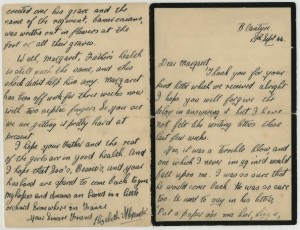
Pages 1 and 4
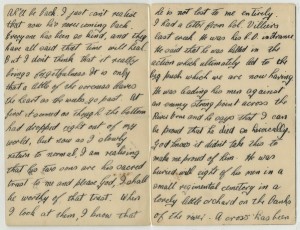
Pages 2 and 3
In response to words of sympathy from her friend, Margaret, Elizabeth Alexander writes:
I just can’t realise that now he’s never coming back. Everyone has been so kind, and they have all said that time will heal. But I don’t think that it really brings forgetfulness. It is only that a little of the soreness leaves the heart as the weeks go past. At first it seemed as though the bottom had dropped right out of my world, but now as I slowly return to normal, I am realising that his two sons are his sacred trust to me and please God, I shall be worthy of that trust. When I look at them, I know that he is not lost to me entirely.
Mrs Alexander goes on to give the circumstances under which her husband was killed, as told by the Commanding Officer of the 9th Battalion Cameronians, Lieutenant Colonel Richard Villiers DSO:
I had a letter from Col. Villiers last week. He was his C.O. in France. He said that he was killed in the action which ultimately led to the big push which we are now having. He was leading his men against an enemy strong point across the River Orne and he says that I can be proud that he died so heroically. God knows it didn’t take this to make me proud of him. He was buried with eight of his men in a small regimental cemetery in a lovely little orchard on the banks of the river. A cross has been erected over his grave and the name of the regiment, Cameronians, was written out in flowers at the foot of all their graves.
She finishes her letter with:
I hope that Isa’s, Bessie’s, and your husband are spared to come back to you, my hopes and dreams are buried in a little orchard somewhere in France.
Your Sincere Friend
Elizabeth Alexander.
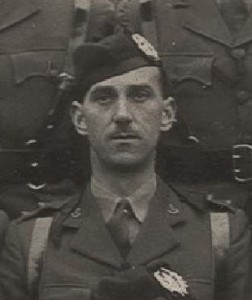
Lieutenant George Alexander
Comments:
VJ Day, 70th Anniversary
Today is the 70th anniversary of the Allied victory over Japan. While the War in Europe against Germany had ended in May, the War in the East carried on until 15th August 1945. While millions in Britain celebrated the Victory against the Nazis, British forces were still engaged in bitter fighting with Japan.
This anniversary provides an opportunity to remember all those who lost their lives in the Far East; in campaigns that were often overshadowed by the war fought in Europe. It also gives an opportunity to remember all those men and women who had been prisoners of war under the Japanese, thousands of whom suffered terrible cruelties at the hands of their captors. We must also not forget those men who returned from the War in the East – many denied by time the heroes welcome they deserved.
It was a sad coincidence that, in the days leading up to this anniversary, we learned of the death of Mr Frank Nicholson, a veteran of the 1st Battalion The Cameronians (Scottish Rifles) who served in Burma and with the Chindits. We are grateful for the fantastic photographs and other material from Mr Nicholson’s service in the Regiment that he bequeathed to the museum collection. We will be adding more of Mr Nicholson’s material to the blog in due course, where I am sure it will be appreciated by many viewers all over the world.
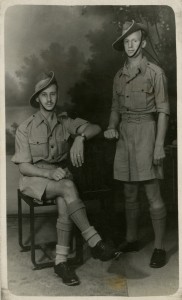
Frank Nicholson, on the right
Frank had been serving with the 1st Battalion Cameronians when the Japanese forces surrendered. His photographs from this time show Cameronian soldiers guarding their Japanese prisoners; a stark contrast to the images seen of British prisoners under the Japanese following the fall of Singapore.
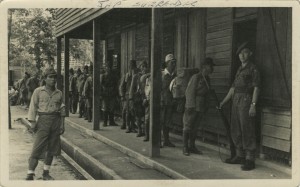
A Cameronian soldier stands guard as a queue of Japanese prisoners await processing.
While this website and blog focuses on the regimental collections of The Cameronians (Scottish Rifles), we feel it only appropriate to acknowledge how significant today’s anniversary is to the families and friends of those soldiers of The Lanarkshire Yeomanry who suffered so terribly in the Far East. The men of the 155th (Lanarkshire Yeomanry) Field Regiment, Royal Artillery, fell into the captivity of the Japanese with the fall of Singapore on 15th February 1942. For the remainder of the War these men endured unimaginable hardships and treatment at the hands of their captors. For more information on the Lanarkshire Yeomanry’s service in the Second World War, please take the time to visit the Lanarkshire Yeomanry Group website – http://www.lanarkshireyeomanry.com/
Comments:
Log in

